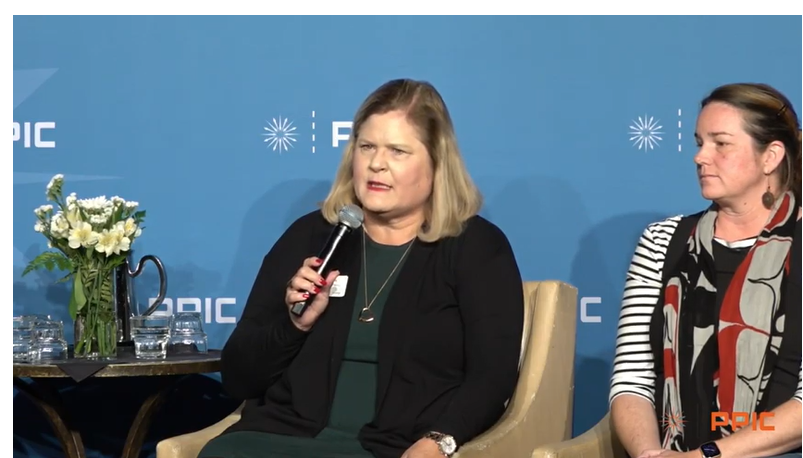Districts Searching for Lower Water Rates Amid a Potential 14% Hike
Talk of a 14% increase in the cost of water is the last straw for the agricultural communities of Fallbrook and Rainbow.
Talk of a 14% increase in the cost of water is the last straw for the agricultural communities of Fallbrook and Rainbow.
The lower Colorado River has been out of balance for about 40 years, using more water than has been available. As their reservoirs empty, the three lower basin states, federal government, and water users are getting around to addressing this problem.
Even in the middle of a cool and wet winter in the Coachella Valley and California in general, officials of the Coachella Valley Water District have a blunt message for the desert’s golf course industry: Take the ongoing drought seriously, because changes could be coming to water availability sooner rather than later.
“We wanted to give the picture as we know it today where the state of play is for our water resources,” said Dr. Robert Cheng, assistant general manager for CVWD and one of the main speakers at a golf and water summit that attracted more than 150 golf industry officials Wednesday at Mission Hills Country Club in Rancho Mirage. “We hope we paint a picture that is accurate, that is dire, that there is a need for additional actions from the golf industry to help them still maintain viability in this current situation.”
San Diego County Water Authority Board Member Jim Madaffer has been elected vice chair of the Colorado River Board of California. The CRB represents California in river management discussions with other Basin states, federal agencies, tribes, and Mexico.
Madaffer, the Water Authority’s CRB representative since 2019, will serve a four-year term as vice chair following his election on January 11 during the CRB meeting in Ontario, Calif. He will serve alongside Imperial Irrigation District Board Vice President JB Hamby, who was elected chair.
“I look forward to working with Chair Hamby and the rest of the Colorado River Board to both protect California’s water supplies during these challenging times and to work collaboratively to keep the river flowing for all users,” said Madaffer, a former chair of the Water Authority Board. “It is essential that California agencies unite to uphold the Law of the River as we seek solutions with the widest possible benefits.”
Established in 1937, CRB consists of agency representatives from the Water Authority, IID, Metropolitan Water District of Southern California, Coachella Valley Water District, Palo Verde Irrigation District, and the Los Angeles Department of Water and Power. Additional representatives include the directors of the California Department of Water Resources and Department of Fish and Wildlife, along with two public representatives.

Jim Madaffer (L) the Water Authority’s CRB representative since 2019, will serve a four-year term as vice chair and will serve alongside Imperial Irrigation District Board Vice President JB Hamby, who was elected chair. Photo: San Diego County Water Authority
CRB’s role has been pivotal in protecting the state’s share of the river during this period when two decades of drought have caused a sharp supply/demand imbalance, leading to a severe decline in water levels in the river’s two main reservoirs, Lake Mead and Lake Powell.
Led by CRB, California has proposed conserving up to 400,000 acre-feet annually through 2026 to support the river. Though that conservation will not affect the San Diego region’s high-priority Quantification Settlement Agreement supplies, the region is continuing to take active steps to conserve as it has over the past three decades.
“The San Diego region is committed to doing our part to be good stewards of our water supplies,” said Water Authority Board Chair Mel Katz. “We also believe in working collaboratively with all stakeholders on the river, and Jim’s leadership on the Colorado River Board in his new role as vice chair will only advance those efforts.”
The Imperial Irrigation District board held their regular meeting Tuesday, January 10 to finalize the 2021 payments to farmers and landowners who conserved water in a verifiable manner. The complex mathematics and tier proportion had been discussed through the year at IID meetings and IID water advisory board meetings.
The California snowpack is starting off strong, raising hopes for water resources throughout the drought-stricken state. But for farmers, these high numbers may not translate into more water for their crops.
The amount of snow high up in the Sierra Nevada Mountains has a direct impact on the fields of crops below. Jason Giannelli, a fourth generation farmer in Kern County who grew up in the farm life, understands this.
Conservation groups are going to court to try to bring back a flowing river in Bakersfield, where for years so much water has been diverted in canals to supply farms that the Kern River is usually reduced to a dry, sandy riverbed.
Reformist farmers in California have deposed the leader of the country’s biggest irrigation district, who was known for fighting water regulations. Farmers are accepting less water means less farming. A local election in rural California caught our attention last month. Farmers ousted the longtime leaders of the organization that supplies their irrigation water, which may sound small, but as Dan Charles reports, it’s a sign of something bigger – farmers reacting to a hotter climate.
After three years of virtual events, the PPIC Water Policy Center’s annual fall conference made a welcome return to an in-person format in Sacramento on Friday, November 18. The half-day event began with a welcome from PPIC Water Policy Center assistant director Caity Peterson and a presentation by senior fellow Jeffrey Mount.
This year was “brutal” for agriculture, said Thad Bettner of the Glenn-Colusa Irrigation District during the first panel, moderated by PPIC Water senior fellow Alvar Escriva-Bou. “We took about 300 square miles out of production.” The drought hit rural and urban communities hard, too: Kyle Jones of the Community Water Center said that “over 1,300 [drinking water] wells went dry.” Bill Hasencamp of Metropolitan Water District described in vivid detail how once-reliable water management strategies are failing, in part due to a lack of interconnections: his agency had to restrict deliveries to “one-third of our service area despite having a record amount of dry-year storage reserves.”
The environment suffered as well, though Sandi Matsumoto of The Nature Conservancy praised the State Water Board, River Partners, and others for efforts to aid wildlife. Well-timed curtailments in some basins, she said, were helpful. But the stakes are high, she said: “Over half of California’s salmon and steelhead species are on a trajectory towards extinction.” And as Hasencamp put it, “drought and climate change have outstripped us.”

Sandra Kerl commended Scripps Institution of Oceanography for their “game-changing” atmospheric river forecasts—and panelists highlighted the promise of Forecast-Informed Reservoir Operations (FIRO) as a tool to make the most of storage infrastructure. Photo: Screenshot from PPIC Water Policy Center annual fall conference Nov. 18.
Capturing more water during wet periods will help California weather the dry periods, said participants in the second panel, moderated by research fellow Andrew Ayres. Sandy Kerl of the San Diego County Water Authority said that investing in reservoir capacity was key after the county suffered a crippling drought in the late ‘80s. “We now have enough storage capacity…to sustain the population at a 75% service level for six months,” she said.
Socking water away in underground water banks is another important strategy, said Mike Tognolini of EBMUD. Such projects rely on good relationships. After some early missteps in a water banking pilot project, he said “we [now] have solid partnerships with local water agencies in San Joaquin County and, importantly…with growers in the region.”
Aaron Fukuda of the Tulare Irrigation District emphasized the importance of trust-building too. “I tell everybody when you want to strike up a partnership, just take them out to dinner,” he said, to laughter. Groundwater recharge works best when relationships are formed first, and how you approach water right holders matters, he said. “When you ask a farmer for help, they will help.”
Kerl commended Scripps Institution of Oceanography for their “game-changing” atmospheric river forecasts—and panelists highlighted the promise of Forecast-Informed Reservoir Operations (FIRO) as a tool to make the most of storage infrastructure. Local agencies are also making good progress in accounting for water once it’s in the ground—key to facilitating more water banking projects.
And, as Julie Rentner of River Partners noted, the stakes for managing the increasingly flood-prone wet periods of our changing climate could not be higher. In 1997, the San Joaquin Valley was hit by a flood that broke the valley’s flood control system in 17 places. Climate projections show that a flood three to five times that magnitude “will likely hit the San Joaquin Valley in our lifetimes.” The damage, she said, would be incalculable. But California’s “new Central Valley flood-protection plan…takes a solid look at multi-benefit projects” that slow floods, recharge groundwater, and support habitat restoration.
The day’s final panel looked at policy’s role in responding to climate conditions. PPIC Water Policy Center director Ellen Hanak sat down with California Department of Water Resources director Karla Nemeth, State Water Board chair E. Joaquín Esquivel, and US Army Civil Works Program assistant secretary Mike Connor. Hanak asked these policy heavy-hitters to share progress and gaps in “this moment of climate whiplash.”
“We’re now in a moment where it’s like ‘Everything, Everywhere, All at Once,’” said Karla Nemeth. “We’re in a multiverse….everything is moving.” Hotter temperatures have now become “their own water demand,” she said, and Californians need to embrace water recycling, desalination, recharge, and conservation—all while keeping water affordable. But California also needs to think big, she said. “We can’t be afraid of taking out big infrastructure or putting in big infrastructure.” As an example of the former, she noted progress on removal of the dams on the Klamath River. And for the latter, she noted that “the Delta conveyance project is enormously important to climate adaptation.”
Esquivel said that water projects that were state-of-the-art 50 years ago now find themselves “mismatched for the climate that we have.” While data has improved, “data alone is not enough. It has to turn into better decision making.” A “greater fidelity to reality,” he said, will be essential. He said compliance across multiple basins with water right curtailments is heartening. “People want to use rights in ways that help support the resilience of us all.”
Mike Connor shared that much of the country still struggles to understand how profoundly conditions have changed. In one eight-week period this summer, he said, “there were six one-in-one-thousand-year precipitation events across the continental US.” He said that “restoring hydrologic function wherever we can…always adds to water availability by keeping it in the system.” All panelists agreed that increased funding, including from the recently passed Inflation Reduction Act, will be a boon to efforts.
We invite you to watch the videos from this event:
(Editor’s Note: Permission to republish blog post granted by PPIC Water Policy Center)
Already grappling with drought, lower commodity prices and higher production costs, more farmers are feeling the added pinch of groundwater regulations as local agencies implement plans that include pumping limits and new fees to balance long-term groundwater resources as required by the state.